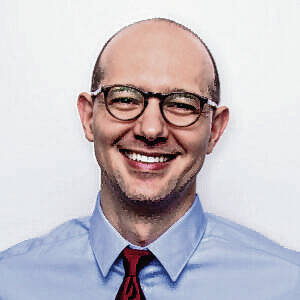Purdue University mathematics professor Clarence Waldo was only at the Indiana Statehouse to lobby for the school during budget talks in February of 1897. That’s when he happened to witness House Bill 246 – to legally change the value of the number pi to 3.2 – pass its third and final reading in the General Assembly’s lower house.
After the vote, a legislator turned to Waldo, who was also the president of the Indiana Academy of Science, and offered to introduce him to the man behind the bill.
The professor declined. His reasoning? “I’m already acquainted with as many crazy people as I care to know.”
The crazy person in question was Edwin Goodwin, a country doctor and amateur mathematician living 20 miles outside of Evansville. Goodwin was obsessed with solving what others had already proven to be an unsolvable problem: using only a standard compass and straightedge, can you construct a square with the same area as a given circle?
The reason it’s impossible: the value of pi, which is derived from the ratio of the circumference of any circle to its diameter. It’s 3.14159265… with digits continuing on forever. For that reason, it’s often approximated as 3.14, and why many math nerds celebrate March 14 as Pi Day.
Edwin Goodwin claimed to have conquered the impossible circle and square challenge, but it required “changing” the value of pi. He claimed God had done just that in March of 1888, directly revealing to him its true value – 3.2 – which made solving the problem possible.
It was nonsense, of course, but that didn’t stop Goodwin from convincing Taylor Record, his state representative, to introduce a bill “for an act introducing a new mathematical truth and offered as a contribution to education to be used only by the State of Indiana …”
Yes, you read that right: in exchange for declaring that the value of pi was what Goodwin said God told him it was, Hoosiers – and only Hoosiers – could use it in the state’s textbooks!
Does it come as any surprise that the Indiana House passed this abomination of a bill unanimously (67 to 0) and did so proudly?
Waldo resolved to make sure the Senate didn’t make the same embarrassing mistake, privately coaching several senators on how to speak against the bill. At the same time, newspapers outside the state were picking up the story, correctly making fun of Indiana legislators for being so easily hoodwinked.
Sen. Orrin Hubbel of Elkhart County took the lead in trying to kill the bill when it reached the floor of the Senate, calling it “utter folly” and stating he and his colleagues “might as well try to legislate water to run up hill as to establish mathematical truth by law,” according to a report in the Indianapolis Journal.
Thankfully, the bill died before coming to a vote, but that was due more to Waldo’s lobbying and the negative publicity than any principled opposition based on basic mathematical knowledge. “All of the senators who spoke on the bill admitted that they were ignorant of the merits of the proposition,” the Journal reported.
More than 125 years later, this story lives on, an urban legend actually or almost true, depending on which version you hear. Maybe that’s because it’s not so far-fetched to imagine the current version of the Indiana General Assembly passing a bill they don’t fully understand, based on easily debunked scientific misinformation – justified by divine revelation, perhaps? – and attracting national ridicule in the process.
The lesson we should take away from the actual events seems clear: in a world full of Edwin Goodwins, be a Clarence Waldo, advocating for facts, evidence, and a rigorous examination of actual data no matter where it might take you.
And if that’s too much to ask, at least find a Clarence Waldo to consult before casting your vote – figuratively or literally – to make sure you’re not being led astray by a self-appointed expert.
After all, aren’t each of us already acquainted with as many crazy people as we care to know?
Nathan Gotsch was an independent candidate for Congress in Indiana’s 3rd District last fall. A former teacher, he lives in Fort Wayne. This commentary previously appeared in indianacapitalchronicle. Send comments to [email protected].





